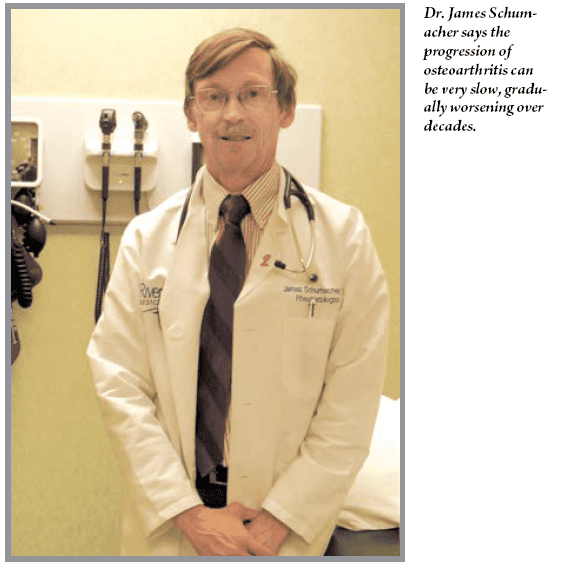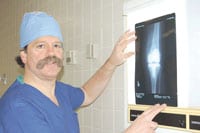Painful Loss – Breakdown of Cartilage Between Joints Leads to Osteoarthritis
More than 27 million Americans suffer from stiff joints and/or pain caused by osteoarthritis, or OA. It is the most common form of arthritis, and although growing older does not cause it, 50{06cf2b9696b159f874511d23dbc893eb1ac83014175ed30550cfff22781411e5} of people over age 65 have some form of OA and suffer from degenerative changes in their joints. Still, the condition is not inevitable, and the pain it causes can often be alleviated.
“There are a lot of people who never develop arthritis, and there are others who do have it whose lives can be markedly improved with appropriate attention,” said orthopedic surgeon Dr. Leonard Wagner of Springfield.
Dr. James Schumacher agrees. “Osteoarthritis a very common disorder, and if you look hard enough, you can find it in everyone 40 or older, particularly in the spine,” said the rheumatologist from Riverbend Medical Group in Chicopee. “But the progression of the disease is very slow and takes place over decades.”
OA can affect the neck, back, hip, knee, shoulder, feet, thumb, or fingers. “Arthritis means inflammation of the joint, and osteoarthritis can affect just one or two joints, compared to other types that can involve the entire body,” Wagner said. The most noticeable symptom is pain in or around the joint, but people can also experience tenderness and/or stiffness and loss of flexibility or range of motion. Some also report a grating sensation or sound in the joint when they move.

The problem is caused by a breakdown of cartilage, which is a tough, elastic, fibrous connective tissue between the bones in the joint that provides them with cushioning. When it becomes too thin, the bones rub together, which leads to inflammation, stiffness, pain, and loss of movement.
But Schumacher says pain increases gradually and is dependent on many factors, such as a person’s weight and how much stress is put on the joint. In addition, what doctors find on X-rays or magnetic-resonance imaging does not necessarily correlate to the degree of pain people experience, he told HCN.
However, some factors, such as obesity, make the problem worse, especially when the knees are affected. Wagner says every extra pound translates to three to four pounds of extra stress on the knee in people with OA. “So if you gain 10 pounds, the knee thinks you gained 40 pounds,” he said.
Keeping active is important, but can be difficult because the more pain a person has, the less likely they are to exercise. “It’s a downward spiral,” Schumacher said. “If you can’t exercise, it’s easy to gain weight, and the more you gain, the more it hurts to exercise.”
However, exercising in a pool is a viable compromise and especially useful for people with OA in their knees, hips, or back. “Even walking in a pool will help,” Schumacher said, adding that some people use college or hotel pools rather than joining a gym. “You don’t have to be a lap swimmer. All you have to do is walk around. But it’s hard to get people interested in going to a pool in the winter.”
Progressive Condition
In addition to obesity, which can make OA worse, other factors put people at risk for the condition. “We don’t really know why osteoarthritis develops, but it is believed that genetics may play a role,” Schumacher said.
There is also a correlation between past injuries and symptoms. They include sports mishaps, car accidents, or a bad fall. In fact, the Arthritis Foundation says researchers have determined that 10 to 20 years after a traumatic injury to the knee — such as an ACL or meniscus tear — about 50{06cf2b9696b159f874511d23dbc893eb1ac83014175ed30550cfff22781411e5} of patients will develop OA.
“The knee is very prone to injury,” Schumacher said. “But any joint can be involved, and if there is a deformity or slight variation in normal structure, it may lead to osteoarthritis.”
The condition occurs over time, and is often referred to as ‘wear-and-tear’ arthritis. Wagner explained that cartilage has a very slippery surface. That surface, combined with a small amount of fluid, keeps the joints lubricated.
However, as the cartilage degenerates or thins out, its surface becomes more like sandpaper, which prevents the bones from gliding easily. As the thinning progresses, they can begin to rub together. “It leads to inflammation, and as the body produces more inflamed cells, there is more and more pain and stiffness,” he said.
At first, pain may be infrequent and only occur with weather changes or when engaging in a strenuous activity. “But as time goes on, the symptoms become more of an issue,” Wagner said, adding that knees tend to be particularly painful because they are weight bearing and people cannot avoid using them because they need to walk.
However, there are measures people can take to help prevent OA. They include maintaining a healthy weight, taking care of injuries when they happen, and staying active. “You don’t need to go to the gym four times a week,” he said. “People just need to keep moving. Every walk you take or every time you take the stairs will help.”
Schumacher agrees. “All exercise counts, even walking from the far end of a parking lot. People who do this are actually getting good exercise. If you only do it once in a while, it will be more difficult, but a small amount is better than nothing, because the body does remember.”
Treatment Options
Wagner says there are a number of modalities used to cope with disabling pain. Many people use canes or walkers. “They can also get injections which decrease inflammation. And certain anti-inflammatory medications can also help to decrease inflammation and discomfort and may make your life more enjoyable. A lot of people take ibuprofen or Aleve and find it is beneficial. But it is important to pay attention to the directions because there is a potential of irritating the stomach.”
Schumacher agreed, and said people who take prescription medications or have other medical conditions should check with their doctor before embarking on a self-treatment plan of over-the-counter medications, as drug interactions and stomach inflammation can occur. “The doctor needs to look at the whole picture and decide what is a reasonable risk.”
Both physicians also urge people with pain that continues over time to visit their physician. “It’s useful to talk to your doctor about your symptoms, get a diagnosis, and find out what treatment is best,” Schumacher said. “A physical exam can detect changes in function, range of motion, and tenderness. We also use X-rays and MRIs to test the severity and extent of osteoarthritis, although there is a lot of variation in symptoms compared to these studies. But our aim is do what we can through medical management.”
However, Wagner says many people fail to schedule a doctor’s visit because they assume they know what is wrong with them and what the physician will prescribe.
“But just because you have pain in a joint doesn’t mean it’s arthritis or you need a particular treatment plan,” he explained. “For example, it’s possible to have pain and swelling in a knee from torn cartilage, even though the person may not remember getting injured. Or someone may have worked too hard in the garden and have tendinitis, which rest and over-the-counter medication will take care of.”
Surgery provides relief for many people, but is not scheduled until other treatment options are exhausted. “Joint replacement is usually the last option,” Schumacher said. “It is a big procedure, and it’s expensive, but for those who are barely able to get around, it can be quite helpful.”
Future Outlook
Osteoarthritis stems from a variety of causes, but is definitely associated with aging. “It is seen in younger people, but that is usually the result of injury or previous trauma to the joint,” Schumacher noted.
And although there is a lot of interest in what makes cartilage deteriorate, it is hard to study.
“Our understanding of why and how osteoarthritis happens is not very good, so even when it is detected early, we don’t have a treatment to change the outlook,” he told HCN. “But it definitely pays to protect your body from injury, control your weight, and stay active.”


Comments are closed.